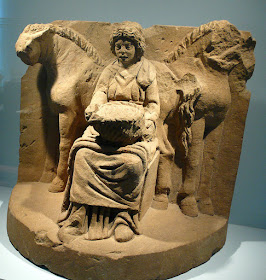 |
| Gaelic Redshank (this is is by Angus McBride) |
The above illustration is of a Gaelic warrior from the west Highlands and Islands. These warriors were often call Redshanks. They were a well known component of Irish armies in the 1500s. Generally, the Redshanks, would travel to Ireland for employment under various Irish chiefs. It was a straight forward business arrangement. They were mercenaries, but within the framework of traditional Gaelic society. The Ó Neill and Ó Dónaill clans were the largest employers. Redshanks were popular among the Irish chiefs as they were elite troops and were more numerous than the famed Gallóglaigh. There are other factors that made them so popular, but I will post on that topic at a later time. This short article will address the business aspect of the Redshanks.
The Redshanks, traditionally, returned back to the Highlands and Islands after a campaign... however, this paradigm changed. In the mid to late 1500s some of the Redshanks began to settle in parts of Ulster, especially in east Donegal and Tyrone, and in north Antrim. These Redshanks came from the same Gaelic clans as had the famous Gallóglaigh during the previous two centuries. The Mac Leóid, Mac Giolla Eáin, Caimbeul, Mac Aodh, and related and allied families, supplied these Redshanks to the Irish chiefs. Clann Chaimbeul was especially adapt at brokering Redshank deals with the Irish chiefs.
The Redshanks, traditionally, returned back to the Highlands and Islands after a campaign... however, this paradigm changed. In the mid to late 1500s some of the Redshanks began to settle in parts of Ulster, especially in east Donegal and Tyrone, and in north Antrim. These Redshanks came from the same Gaelic clans as had the famous Gallóglaigh during the previous two centuries. The Mac Leóid, Mac Giolla Eáin, Caimbeul, Mac Aodh, and related and allied families, supplied these Redshanks to the Irish chiefs. Clann Chaimbeul was especially adapt at brokering Redshank deals with the Irish chiefs.
 |
| Gaelic Scot drawn from life, de Heere 1570s |
The Redshanks took service in Ulster and in
other places in Europe for the money. Being a Redshank soldier was profitable.
Most of the Redshanks came from Argyll, Lennox, and the Hebrides, but
some came from the west Scottish Lowlands. In the sixteenth century, during
their heyday, the pay was good and grew in the second half of the century as
the wars in Ulster between the Irish and the Elizabethan English grew in size
and scope.
By 1575, a Redshank Consapal (constable or 'captain') was on the same pay-scale as a Gallóglaigh captain according to the Calendar of State Papers concerning Ireland. The pay-scale during this time was on the increase because demand for Redshanks was greater than the supply. In 1553, a Gallóglach received the equivalent of 4d (pence) per day, but by 1562 the pay had risen to 8d a day. The Consapal received considerably higher wages. This was done via deadpays, or the wages of a soldier in a córugud (company) that went consapal. The standard córugud was 100 men on paper, but the actual number of men would normally be circa 87 and the pay of the absent men would go to the consapal as deadpays.
By 1575, a Redshank Consapal (constable or 'captain') was on the same pay-scale as a Gallóglaigh captain according to the Calendar of State Papers concerning Ireland. The pay-scale during this time was on the increase because demand for Redshanks was greater than the supply. In 1553, a Gallóglach received the equivalent of 4d (pence) per day, but by 1562 the pay had risen to 8d a day. The Consapal received considerably higher wages. This was done via deadpays, or the wages of a soldier in a córugud (company) that went consapal. The standard córugud was 100 men on paper, but the actual number of men would normally be circa 87 and the pay of the absent men would go to the consapal as deadpays.
The consapal received his
pay and 13 addition soldiers' pay which was a substantial wage in that day. The pay was received in a variety of ways. It could be cattle, or
goods, or food, etc., or coin realm. If in coin realm there was
considerable difference between pay in Scots coinage, Irish coinage, and
English coinage. Scots money in particular was considerably debased
and worth much less than English money.
The Redshanks adopted the kilt, or
féileadh, as part of the unique dress in the 1500s. In 1595, Lughnaidh Ó
Cléirigh described a troop of kilted Redshanks in County Derry in the service
of the Ó Dónaill clan.
Captain 8s ($390)
sub captain 4s ($192)
Leeche (medic) 4s ($192)
sergeant 1s ($48)
soldier 8d ($32)
For perspective, the yearly income of a
country squire at this time was around 100 to 150 pounds. A Redshank
consapal could expect at least 72 pounds for a half year's work, plus would
often have other benefits, such as a horse to ride, a pack horse, and arms,
supplied to him. This would put him on par with the gentry of his age.
A particularly well placed and successful Redshank consapal could earn
more than this figure and rise to the ranks of an elevated country squire or
more.
The Redshanks are a interesting aspect of Irish history, one that should be studied more. They had a great impact on Irish society. Their dialect of Gaelic influenced Ulster Irish and their descendants are still found in Ireland, easily recognised by their surnames.
If you enjoy the articles that appear in McCain's Corner, please make a donation.




















